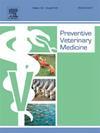Exploring the operational logistics of implementing isolation protocols at equestrian facilities
IF 2.2
2区 农林科学
Q1 VETERINARY SCIENCES
引用次数: 0
Abstract
Horses may travel for a variety of reasons, leading to potential exposure to pathogens. Typically, these movements are bidirectional with horses returning to their home facility, therefore also risking pathogen exposure to resident horses at home facilities. The Canadian National Farm and Facility Level Biosecurity Standard for the Equine Sector was designed to outline best practices for managing biosecurity at equestrian facilities, however, there is a gap between the implementation of these recommendations and the day-to-day operations of equestrian facilities. This study aimed to explore the challenges and opportunities for implementing biosecurity protocols at equestrian facilities through an isolation activity for a mock pathogen. This study was performed at seven Ontario equestrian facilities and used a fluorescent spray as a proxy for a pathogen along with the subsequent implementation of biosecurity measures. Pre- and post-study interviews were also conducted with participants to gain additional insight into the feasibility of instituting an isolation protocol. Facility-level, qualitative, descriptive summaries and a survival analysis were used to outline some of the discovered challenges including weather, staff training, time constraints, and compliance. There were also horse-level considerations such as turnout procedures and stabling requirements. Results indicated the potential for a feasible subset of all biosecurity practices to effectively reduce risk of non-airborne transmission, counteracting the perception that biosecurity is effective only when performed completely and without exception. This could lead to additional incorporation of biosecurity measures in equestrian facilities’ daily operations to support continued maintenance of health and welfare in the equine population.
探索在马术设施实施隔离协议的操作后勤
马可能会因为各种各样的原因而旅行,从而导致潜在的病原体暴露。通常情况下,这些活动是双向的,马匹返回其家庭设施,因此也有可能使家庭设施中的马匹暴露于病原体。加拿大国家马场和设施生物安全标准旨在概述管理马术设施生物安全的最佳做法,然而,这些建议的实施与马术设施的日常运营之间存在差距。本研究旨在通过模拟病原体的隔离活动,探讨在马术设施实施生物安全协议的挑战和机遇。这项研究是在安大略省的七个马术设施中进行的,并使用荧光喷雾作为病原体的代理,随后实施了生物安全措施。还对参与者进行了研究前和研究后的访谈,以进一步了解制定隔离协议的可行性。使用设施级别、定性、描述性总结和生存分析来概述发现的一些挑战,包括天气、员工培训、时间限制和合规。也有马匹层面的考虑,如投票率程序和马厩的要求。结果表明,所有生物安全措施的可行子集都有可能有效降低非空气传播的风险,从而抵消了生物安全只有在完全和毫无例外地实施时才有效的看法。这可能导致在马术设施的日常运营中额外纳入生物安全措施,以支持继续维持马群的健康和福利。
本文章由计算机程序翻译,如有差异,请以英文原文为准。
求助全文
约1分钟内获得全文
求助全文
来源期刊

Preventive veterinary medicine
农林科学-兽医学
CiteScore
5.60
自引率
7.70%
发文量
184
审稿时长
3 months
期刊介绍:
Preventive Veterinary Medicine is one of the leading international resources for scientific reports on animal health programs and preventive veterinary medicine. The journal follows the guidelines for standardizing and strengthening the reporting of biomedical research which are available from the CONSORT, MOOSE, PRISMA, REFLECT, STARD, and STROBE statements. The journal focuses on:
Epidemiology of health events relevant to domestic and wild animals;
Economic impacts of epidemic and endemic animal and zoonotic diseases;
Latest methods and approaches in veterinary epidemiology;
Disease and infection control or eradication measures;
The "One Health" concept and the relationships between veterinary medicine, human health, animal-production systems, and the environment;
Development of new techniques in surveillance systems and diagnosis;
Evaluation and control of diseases in animal populations.
 求助内容:
求助内容: 应助结果提醒方式:
应助结果提醒方式:


